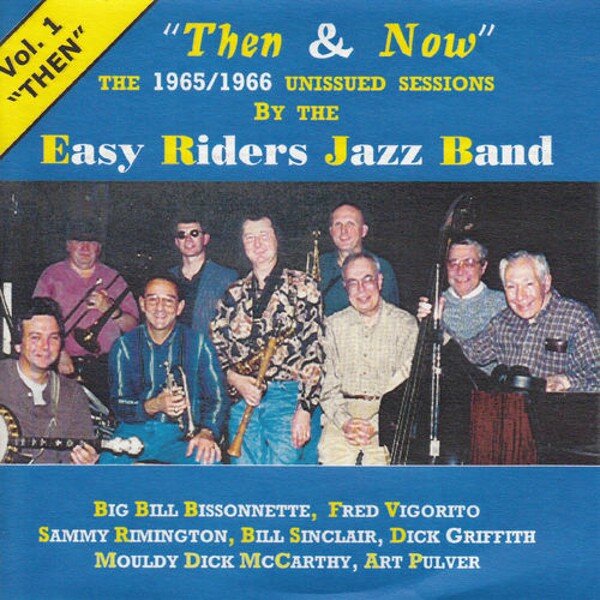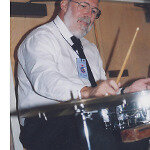George Lewis and the Easy Riders Jazz Band Vol. 1
 This album is vol. 1, "Then," of a two-volume set of the Easy Riders Jazz Band on the Jazz Crusade label, titled "Then" and "Now." (The second volume ["Now" – JCCD3038] is a reunion of as many members of this original band as were still alive, assembled in 1998 by the late Big Bill Bissonnette.)
This album is vol. 1, "Then," of a two-volume set of the Easy Riders Jazz Band on the Jazz Crusade label, titled "Then" and "Now." (The second volume ["Now" – JCCD3038] is a reunion of as many members of this original band as were still alive, assembled in 1998 by the late Big Bill Bissonnette.)
Bissonnette, as many traditional jazz fans know, was dedicated to the preservation of New Orleans-style jazz, and two of his projects toward that end were first the formation in Connecticut of the Easy Riders Jazz Band in the early 1960s and second the creation of the record label Jazz Crusade to record local groups and musicians.
After a period of inactivity of some fifteen years during the 1970s and 1980s, Bissonnette resumed his musical ventures and began a third project, setting down in 1990 his record of the 1960s revival of traditional jazz in the book The Jazz Crusade: The Inside Story of the Great New Orleans Jazz Revival of the 1960's (the book's publishing date is given as 1992) and beginning to play again. In addition he arranged tours and recordings with New Orleans jazz veterans, most of whom he brought up from New Orleans. He assiduously engaged in that "crusade," carrying the banner after his retirement in 2006 until his death a year ago.
The band here on vol. 1, "Then," is young and relatively inexperienced. It displays much vigor and a somewhat primitive quality, but it is quite exciting. In spite of the occasional roughness displayed, the dedication is unmistakable, as is the devotion to the New Orleans polyphonic style of playing. Rimington is clearly at this stage in his career a disciple of George Lewis, and Vigorito of Kid Thomas Valentine.
Rimington is a monster of technique, executing such runs and trills, such ease of execution in all of the clarinet's registers as to belie his young age, only some 23 years. He also can, and does, take several choruses in a solo. In some ways one could say that the album is a showcase for Rimington. Vigorito shows his devotion to Kid Thomas Valentine with his many flares and flourishes and mute work on most of the tunes on this CD.
The tune list is an inspired one—a good mix of the familiar and the less so. Several of the tunes were not often heard on traditional jazz CDs back then, and still are not. The opening number, "Early Hours," is one of these, getting the proceedings off to a good start, putting one in mind of the original Colyer rendition. Rimington is quite dazzling, and Sinclair emphatically indicates his presence with short runs, adding up to a satisfying performance of one of my favorite tunes.
The second track is a jaunty, rollicking version of "It's Tite [sic] Like That," Vigorito throwing in some Kid Thomas voicing, the rhythm section providing a solid backing—obviously the band is having a great time with this tune, and there is not the vocal one has come to expect. (I don't know why the variant spelling "tite," unless it is an attempt to pun on "tite" meaning fast or quick to complement the tempo.)
Tempting as it would be to examine each of the selections on the CD, I will simply summarize by saying that collectively they exhibit the variety of tempo and the abundance of technique the first two tracks display. There are a couple of small surprises along the way, perhaps. "Dead Man Blues" is not taken at a dirge or very slow tempo but instead is quite perky, although ending fairly uncertainly. "Gettysburg March" and "Bugle Boy March" come across as more "runs" than "marches," but despite the fast tempi the band, in each case, manages to avoid any train wrecks or collisions.
For a final comment, I found "Easy Rider Drop-Out Blues" rather strange. It is not, as I anticipated before hearing it, a version of "Easy Rider" but is rather an up-tempo jam blues which seems to lack direction. Possibly the "drop-out" refers not only to high school dropouts, according to Bissonnette's dedication in the spoken intro, but also to the part where Rimington is left to carry the tune a couple of times—once for a true solo where everyone else "drops out" for the 12 bars, and again in the ending choruses where one by one the musicians drop out in successive 12-bar choruses until Rimington is left to take the 12-bar coda, again totally solo. I find the track is a bit too long, lacking enough interest. But these are somewhat minor cavils.
It is a nice exercise to compare the two bands on this dual set, even though there are several changes in personnel. The front line is the same in both bands, but the difference in the maturity of their playing is quite apparent. In the second set "Now," Rimington is not so intent on amazing the listener with the number of notes he can squeeze in but rather seems to choose them by quality rather than quantity. Vigorito displays more confidence and comes more to the fore in the later set. The entire band is less brash and has less of a "take-no-prisoners" approach but retains the excitement.
This album, "Then," provides over an hour of entertaining, satisfying traditional jazz, some of the musicians still playing some 55 years later—Vigorito, Rimington, and, as far as I know, Sinclair. Along with vol. 2, it documents an important part of traditional jazz history, and by reissuing these Jazz Crusade CDs, Upbeat continues to play a valuable part in preserving jazz history and keeping it available.
Jazz Crusade CDs are available on the Upbeat web site www.upbeat.co.uk as well as from on-line sites such as Amazon.
EASY RIDERS JAZZ BAND—"Then" and "Now," Vol. 1 (Jazz Crusade JCCD3037)
Playing time: 67m. 03s.
1. Early Hours; 2. It's Tite [sic] Like That; 3. Trouble in Mind; 4. The Sheik of Araby; 5. Dead Man Blues; 6. Gettysburg March; 7. Just a Closer Walk with Thee; 8. Over the Waves; 9. Summeertime; 10. Bugle Boy March; 11. After You've Gone; 12. Easy Rider Drop-Out Blues; 13. The Old Rugged Cross.
Big Bill Bissonnette, trombone, vocal*; Sammy Rimington, reeds; Fred Vigorito, cornet; Bill Sinclair, piano; Dick Griffith, banjo; Mouldy Dick McCarthy, string bass; Art Pulver, drums,
Recorded: tracks 1-4, 6-7, 10 at West Haven Motor Inn, Connecticut on August 10, 1965;
tracks 5, 8-13 at Glorieta Manor, Bridgeport, Connecticut on February 25, 1966.

Bert Thompson
Born in Dundee, Scotland, Bert Thompson came to the U.S. in 1956. After a two-year stint playing drums with the 101 st Airborne Division Band and making a number of parachute drops, he returned to civilian life in San Francisco, matriculating at San Francisco State University where he earned a B.A. and an M.A. He went on to matriculate at University of Oregon, where he earned a D.A. and a Ph.D., all of his degrees in English. Now retired, he is a professor emeritus of English at City College of San Francisco. He is also a retired traditional jazz drummer, having played with a number of San Francisco Bay Area bands, including And That's Jazz, Professor Plum's Jazz, the Jelly Roll Jazz Band, Mission Gold Jazz Band, and the Zenith New Orleans Parade band; he also played with some further afield, including Gremoli (Long Beach, CA) and the Phoenix Jazzers (Vancouver, B.C.) Today he reviews traditional jazz CDs and writes occasional articles for several publications.
christisonthaparme.blogspot.com
Source: https://syncopatedtimes.com/easy-riders-jazz-band-%E2%80%A2-then-and-now-vol-1/
0 Response to "George Lewis and the Easy Riders Jazz Band Vol. 1"
Post a Comment